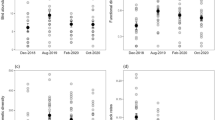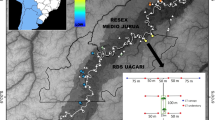Summary
We provide experimental evidence that predators are a major factor organizing a community of granivorous grassland birds (mostly emberizid finches). Our focus is not on the lethal effects of predators, but on the simple idea that (i) birds will not settle where they perceive a high risk of predation, and (ii) species differ in their perception of the safety of woody vegetative cover due to differences in antipredator escape behavior. Consistent with this idea is the fact that the composition of this grassland community responds markedly to minor manipulations in the distribution of woody cover. In particular, with the addition of cover to open grasslands, species with cover-dependent escape tactics increase in abundance, while the abundance of “cover-independent” species decreases greatly; this decrease may reflect aggression from cover-dependent species, but evidence suggests that some cover-independent species may actively avoid cover-rich areas per se. Non-predatory effects of cover, most notably those concerning food resources and microclimate, appear unable to explain these results. Predators may influence many communities of terrestrial vertebrates via species-specific responses to cover.
Similar content being viewed by others
References
Bahre CJ (1977) Land-use history of the Research Ranch, Elgin, Arizona. J Arizona Acad Sci 12:1–32
Bakken GS (1980) The use of standard operative temperature in the study of the thermal energetics of birds. Physiol Zool 53:108–119
Bakken GS (1989) Arboreal perch properties and the operative temperature experienced by small animals. Ecology 70:922–930
Black RW, Hairston NG Jr (1988) Predator driven changes in community structure. Oecologia 77:468–479
Bock CE (1987) Distribution-abundance relationships of some Arizona land birds: a matter of scale. Ecology 68:124–129
Bock CE, Webb B (1984) Birds as grazing indicator species in southeastern Arizona. J Wildl Manage 48:1045–1049
Bock CE, Bock JE (1988) Grassland birds in southeastern Arizona: impacts of fire, grazing, and alien vegetation. International Council on Bird Preservation, Technical Publication No. 7
Bock CE, Bock JE, Kenney WR, Hawthorne VM (1984) Responses of birds, rodents, and vegetation to livestock exclosure in a semidesert grassland site. J Rang Man 37:239–242
Brown JS (1989) Desert rodent community structure: a test of our mechanisms of coexistence. Ecol Monogr 59:1–20
Brown JS, Kotler BP, Smith RJ, Wirtz EO (1988) The effects of owl predation on the foraging behavior of heteromyid rodents. Oecologia 76:408–415
Buchanan JB, Schick CT, Brennan LA, Herman SG (1988) Merlin predation on wintering dunlins: hunting success and dunlin escape tactics. Wilson Bull 100:108–118
Byman D, Hay DB, Bakken GS (1988) Energetic costs of the winter arboreal microclimate: the gray squirrel in a tree. Int J Biometeorol 32:112–122
Caraco T, Martindale S, Pulliam HR (1980) Avian time budgets and distance to cover. Auk 97:872–875
Cody ML (1985) Habitat selection in grassland and open-country birds. In: Cody ML (ed) Habitat selection in birds. Academic Press, NY
Davis J (1973) Habitat preferences and competition of wintering juncos and golden-crowned sparrows. Ecology 54:174–180
Diamond JM (1978) Niche shifts and the rediscovery of interspecific competition. Am Scient 79:2420–2424
Dunning JB Jr (1984) Body weights of 686 species of North American birds. Western Bird Banding Association, Monograph No. 1
Dunning JB Jr, Brown JH (1982) Summer rainfall and winter sparrow densities: a test of the food limitation hypothesis. Auk 99:123–129
Ehrlich PR, Dobkin DS, Wheye D (1988) The birder's handbook: a field guide to the natural history of North American birds Simon and Schuster, NY
Ekman J (1986) Tree use and predator vulnerability of wintering passerines. Ornis Scand 17:261–267
Ekman J (1987) Exposure and time use in willow tit flocks: the cost of subordination. Anim Behav 35:445–452
Erlinge S, Goransson G, Hogstedt G, Jansson G, Liberg O, Loman J, Nilsson IN, von Schantz T, Sylven M (1988) More thoughts on vertebrate predator regulation of prey. Am Nat 132:148–154
Errington PL (1946) Predation and vertebrate populations. Q Rev Biol 21:144–177
Errington PL (1956) Factors limiting higher vertebrate populations. Science 124:304–307
Gates DM (1980) Biophysical ecology. Springer-Verlag, New York
Gilliam JF, Fraser DF, Sabat AM (1989) Strong effects of foraging minnows on a stream benthic invertebrate community. Ecology 70:445–452
Grant PR (1986) Ecology and evolution of Darwin's Finches. Princeton University Press, New Jersey, USA
Grubb TC Jr (1977) Weather-dependent foraging behavior of some birds wintering in a deciduous woodland: horizontal adjustments. Condor 79:271–274
Grubb TC Jr, Greenwald L (1982) Sparrows and a brushpile: foraging responses to different combinations of predation risk and energy cost. Anim Behav 30:637–640
Grzybowski JA (1983) Sociality of grassland birds during winter. Behav Ecol Sociobiol 13:211–219
James FC, Boecklen WJ (1984) Interspecific morphological relationships and the densities of birds. In Strong DR, Simberloff D, Abele LG, Thistle AB (eds) Ecological communities: conceptual issues and the evidence. Princeton University Press, Princeton, NJ
Kerfoot WC, Sih A (1987) Predation: direct and indirect impacts on aquatic communities. University Press of New England, Hanover, New Hampshire, USA
Kidd NAC, Lewis GB (1987) Can vertebrate predators regulate their prey? A reply. Am Nat 130:448–453
Kotler BP, Brown JS (1988) Environmental heterogeneity and the coexistence of desert rodents. Ann Rev Ecol Syst 19:281–307
LackD (1954) The natural regulation of animal numbers. Clarendon, Oxford UK
Lima SL (1987) Distance to cover, visual obstructions, and vigilance in house sparrows. Behaviour 102:231–238
Lima SL (1988) Initiation and termination of daily feeding in dark-eyed juncos: influence of predation risk and energy reserves. Oikos 53:3–11
Lima SL (1990) Protective cover and the use of space: different strategies in finches. Oikos 58:151–158
Lima SL, Dill LM (1990) Behavioral decisions made under the risk of predation: a review and prospectus. Can J Zool 68:619–640
Loyn RH, Runnalls RG, Forward GY, Tyers J (1983) Territorial bell miners and other birds affecting populations of insect prey. Science 221:1411–1412
MacArthur RH (1958) Population ecology of some warblers of northeastern coniferous forests. Ecology 39:599–619
Marcstrom V, Kenward RE, Engren E (1988) The impact of predation on boreal tetraonids during vole cycles: an experimental study. J Anim Ecol 57:859–872
Martin AC, Zim HS, Nelson AL (1951) American wildlife and plants: a guide to wildlife food habits. McGraw-Hill, New York
Martin TE (1988) Processes organizing open-nesting bird assemblages: competition or nest predation? Evol Ecol 2:37–50
Mittelbach GG, Chesson PL (1987) Predation risk: indirect effects on fish populations. In: Kerfoot WC, Sih A (eds) Predation: direct and indirect impacts on aquatic communities. University Press of New England, Hanover, New Hampshire, pp 315–332
Morse DH (1974) Niche breadth as a function of social dominance. Am Nat 108:818–830
Newsome AE, Parer I, Catling PC (1989) Prolonged prey suppression by carnivores: predator removal experiments. Oecologia 78:458–467
Paine RT (1966) Food web complexity and species diversity. Am Nat 100:65–75
Persson L (1985) Asymmetrical competition: are larger animals competitively superior? Am Nat 126:261–266
Peterson RO (1977) Wolf ecology and prey relationships on Isle Royale. National Park Service Science Monograph Series No. 11
Price MV (1986) Structure of desert rodent communities: A critical review of questions and approaches. Am Zool 26:39–49
Pulliam HR (1983) Ecological community theory and the coexistence of sparrows. Ecology 64:45–52
Pulliam HR, Mills GS (1977) The use of space by wintering sparrows. Ecology 58:1393–1399
Pulliam HR, Parker TA (1979) Population regulation of sparrows. Fortschrif Zool 25:137–147
Pulliam HR, Dunning JB (1987) The influence of food supply on local density and diversity of sparrows. Ecology 68:1009–1014
Risch SJ, Carroll CR (1982) Effect of a keystone predaceous ant, Solenopsis geminata, on arthropods in a tropical agroecosystem. Ecology 63:1979–1983
Rosenzweig ML (1973) Habitat selection experiments with a pair of co-existing heteromyid rodent species. Ecology 54:111–117
Rotenberry JT (1980) Dietary relationships among shrubsteppe passerine birds: competition or opportunism in a variable environment? Ecol Monogr 50:93–110
Schluter D (1988) The evolution of finch communities on islands and continents: Kenya vs. Galapagos. Ecol Monogr 58:229–249
Schneider KJ (1984) Dominance, predation, and optimal foraging in white-throated sparrows. Ecology 65:1820–1827
Schoener TW (1965) The evolution of bill size differences among sympatric species of birds. Evolution 19:189–213
Schoener TW, Spiller DA (1987) Effects of lizards on spider populations: manipulative reconstruction of a natural experiment. Science 236:949–952
Sih A (1987) Predators and prey lifestyles: an evolutionary and ecological overview. In: Kerfoot WC, Sih A (eds) Predation: direct and indirect impacts on aquatic communities. University Press of New England, Hanover, New Hampshire, USA
Sih A, Crowley P, McPeek M, Petranka J, Strohmeier K (1985) Predation, competition, and prey communities: a review of field experiments. Ann Rev Ecol Syst 16:269–311
Taylor RJ (1984) Predation. Chapman and Hall, New York
Thorp JH (1986) Two distinct roles for predators in freshwater assemblages. Oikos 47:75–82
Trostel K, Sinclair ARE, Walters CJ, Krebs CJ (1987) Can predation cause the 10-year hare cycle? Oecologia 74:185–192
Valon TJ, Lima SL (1987) Carrying food items to cover for consumption: the behavior of ten bird species feeding under the risk of predation. Oecologia 71:286–294
Werner EE, Gilliam JF, Hall DJ, Mittelbach GG (1983) An experimental test of the effects of predation risk on habitat use in fish. Ecology 64:1540–48
Wiens JA (1990) The ecology of bird communities: 2. Processes and variations. Cambridge University Press, NY
Wiens JA, Rotenberry JT (1979) Diet niche relationships among North American grassland and shrubsteppe birds. Oecologia 42:253–292
Wiens JA, Rotenberry JT (1980) Patterns of morphology and ecology in grassland and shrubsteppe bird populations. Ecol Monogr 50:287–308
Wiens JA, Rotenberry JT, Van Horne B (1986) A lesson in the limitations of field experiments: shrubsteppe birds and habitat alteration. Ecology 67:365–376
Zaret TJ (1980) Predation and freshwater communities. Yale University Press, New Haven
Author information
Authors and Affiliations
Rights and permissions
About this article
Cite this article
Lima, S.L., Valone, T.J. Predators and avian community organization: an experiment in a semi-desert grassland. Oecologia 86, 105–112 (1991). https://doi.org/10.1007/BF00317396
Received:
Accepted:
Issue Date:
DOI: https://doi.org/10.1007/BF00317396




